Common menu bar links
Breadcrumb Trail
ARCHIVED - Department of Justice Canada - Report
 This page has been archived.
This page has been archived.
Archived Content
Information identified as archived on the Web is for reference, research or recordkeeping purposes. It has not been altered or updated after the date of archiving. Web pages that are archived on the Web are not subject to the Government of Canada Web Standards. As per the Communications Policy of the Government of Canada, you can request alternate formats on the "Contact Us" page.
SECTION II: ANALYSIS OF PROGRAM ACTIVITIES BY STRATEGIC OUTCOME
Strategic Outcome I: A fair, relevant and accessible justice system that reflects Canadian values

Ensuring a fair, relevant and accessible justice system that reflects Canadian values requires an integrated network of partnerships and participation of a broad range of stakeholders including, at the federal level - Parliament, the judiciary, and federal departments and agencies; provincial, territorial and municipal levels of government; a broad range of non-governmental organizations and stakeholders; and, most importantly, 34 million Canadians.
Three expected results illustrate what the Department strives to achieve in support of this Strategic Outcome:
- The Department continually responds to the evolving legal framework.
- Policies and laws are developed in response to identified needs and gaps.
- Programs are developed and implemented in response to identified needs and gaps, and are integrated with Government of Canada priorities and commitments.
Two Program Activities contribute to the achievement of these expected results: Justice policies, laws and programs, and the Office of the Federal Ombudsman for Victims of Crime.
| Program Activity A1: Justice policies, laws and programs | |||||
|---|---|---|---|---|---|
| 2009-10 Financial Resources ($ millions) | 2009-10 Human Resources (FTEs) | ||||
| Planned Spending | Total Authorities | Actual Spending | Planned | Actual | Difference |
| $431.5 | $439.3 | $436.4 | 298 | 356 | 58 |
Program Activity A.1: Justice policies, laws and programs
Under Canada's federal system, the administration of justice is an area of shared jurisdiction between the federal government and the provinces. Through this Program Activity, the Department fulfills its constitutional responsibility to ensure a bilingual and bijural national legal framework for the administration of justice by developing policies, laws and programs to strengthen the national framework. The Department's focus is in five core domains which include: criminal justice (which includes youth justice and victims of crime), family justice, access to justice, Aboriginal justice and private international and public law.
In addition, in view of the federal government's shared interest in a sustainable justice system, the Department provides significant ongoing funding to provinces and territories for the delivery of programs that directly support federal policy objectives, including legal aid, youth justice services, and Aboriginal justice services.
| Expected Results | Performance Indicators1 | Performance Status | Performance Summary |
|---|---|---|---|
| Maintain a sustainable national justice system | Trends in the crime index Trends in per capita spending by all levels of government in Canada on the justice system Trends in lag time from charges to court resolution |
Met | Crime Severity Index (CSI) decline by 4% in 2009. Overall Crime Rate decline by 3%. Violent CSI declined by 1% Violent Crime Rate declined by 1% Youth CSI declined by 2% Youth Violent CSI remained stable |
| Met | Details about Departmental spending in support of sustainable justice system are found in the on-line tables at: http://www.tbs-sct.gc.ca/dpr-rmr/2009-2010/index-eng.asp | ||
| Met | Mean average number of days declined from 261 to 2322 |
Benefits to Canadians
Canadians rely on the justice system to prescribe the balance between collective and individual rights and responsibilities that ensure a safe, secure and resilient society. The justice system affects almost every facet of Canadians' daily lives from guiding everyday activities that ensure our safety, to supporting social policies and social benefits, regulating our economy, and offering ways to resolve disputes peacefully where there are disagreements or conflicts between individuals, organizations or governments.
As the administration of justice is shared between jurisdictions, the Department of Justice works in partnership with federal departments and agencies, the Provinces and Territories, municipal governments and a broad range of non-governmental organizations and stakeholders to ensure that justice policies, laws and programs balance collective and individual rights and responsibilities with the aim of ensuring a safe, secure and resilient society.
The Department seeks to enhance community involvement through programs and consultative mechanisms in addressing key issues related to youth justice, family justice and Aboriginal justice. The Department also seeks through programs to enhance support for victims of crime to enable them to participate effectively in the justice system. The Department's work in support of criminal law reforms is aimed at addressing gaps and priorities identified by the public, the law enforcement community, and the Provinces and Territories. The Department also works closely with the Provinces and Territories to modernize and streamline family justice tools and to address gaps and identified issues in the national legal framework. As well, the Department works with international partners to address, through policy and legal reform activities, global crime and terrorism in order to enhance the safety of Canadians here and abroad while respecting the values of democracy, human rights and the rule of law.
Performance Summary
The Department was actively engaged in supporting the Minister's legislative agenda. During the reporting period, 14 Bills were introduced in Parliament3 and three of the 14 Bills received Royal Assent. Bill C-14, an Act to amend the Criminal Code4, amended the Criminal Code of Canada in order to enhance the capacity of the criminal justice system to address organized crime. The provisions of the Act modernized Canada's efforts to deal with this issue effectively, in addition to prioritizing the protection of justice system participants. Bill C-25, an Act to amend the Criminal Code5 - also known as the Truth in Sentencing Act - limited the credit that convicted offenders receive for time spent in pre-sentencing custody and Bill S-4, an Act to amend the Criminal Code6 addressed the offence of identity theft and related misconduct. This Act modernized Canada's efforts to deal with growing areas of criminal activity.
As well, the Department continued to support the Minister in reviewing the approach to addressing youth justice issues. The Department convened an experts' roundtable meeting on youth gangs, a national workshop for police identifying mental health resources for youth, and a roundtable on the implications of youth cognitive development.
The Department was also active in supporting community-level initiatives to address youth justice issues. In 2009-2010, the Department focused its efforts in three areas: youth gangs; drug treatment for youth in conflict with the law; and youth in conflict with the law with Fetal Alcohol Spectrum Disorder, or youth with mental health concerns. Among other projects, the Department provided funding to ten police forces to develop directories and databases of community programs to which youth could be referred; supported the organization of 21 regional conferences on gang-involved youth; and funded a variety of community based programs dealing with, for example, Aboriginal youth gangs and providing training for volunteers in the youth justice system.
The Department of Justice provided effective leadership to the implementation and coordination of the horizontal National Anti-Drug Strategy (NADS). The Department supported the process for Parliamentary consideration of a Government Bill to address serious drug crimes and collaborated with partner departments to conduct the Implementation Evaluation and to develop an agreed-upon management response, including action plans for follow-up on the three recommendations flowing out of the evaluation. The evaluation found that all policy and program components of the Strategy across 12 departments and agencies have been implemented with the exception of the proposed Mandatory Minimum Penalty (MMP) legislation. In addition, the Department oversaw NADS involvement in the development of a new Hemispheric Drug Strategy at the Organization of American States. The Department also extended program funding for six Drug Treatment Courts until 2012.
In terms of spending in support of a sustainable justice system7, the Department continued to provide funding to the Provinces and Territories to assist with the costs of youth justice services that support federal youth justice policy objectives and are essential to the ongoing successful implementation of the Youth Criminal Justice Act. Despite a capping of federal funding at 2006/07 funding levels, all jurisdictions continue to provide the same range of high priority youth justice services as in previous years.
The Department also continued to support access to justice by providing program funding to the Provinces and Territories to assist them in the delivery of legal aid programs aimed at providing legal assistance to economically disadvantaged individuals facing serious criminal charges. In 2009-10, the Department contributed $111.9 million among all 13 jurisdictions for criminal legal aid. In addition, $17.5 million in interim funding for immigration and refugee legal aid was provided through the Department to the six participating provinces (British Columbia, Alberta, Manitoba, Ontario, Quebec and Newfoundland and Labrador).
In support of Victims of Crime, the Department spent $248,695 for 346 victims and 89 support persons to attend National Parole Board hearings and spent $210,702 in direct funding for 57 Canadians victimized abroad. In terms of grants and contributions, $2,623,659 was spent to fund a wide range of stakeholders for 67 projects including training events, program evaluations, research, and community activities. Provinces and Territories received $1,827,416 to help meet the needs of under-served victims of crime and/or to help support victims in attending sentencing hearings and in submitting their Victim Impact Statements.
The Department also actively supported families, responding to 23,671 tracing applications from provincial maintenance enforcement programs to locate debtors in default of child support obligations, and garnisheeing $168 million and providing it to Provinces and Territories for distribution to families. This amounted to a $26 million dollar increase from the previous year ($142 million).
Through the Aboriginal Justice Strategy, which enables Aboriginal communities to have increased involvement in the local administration of justice, the Department also supported 142 community-based programs and 47 capacity building projects serving 400 Aboriginal communities across Canada, and through the Aboriginal Courtwork Program, provided funding to enable the delivery of services to over 51,555 Aboriginal adults and 10,534 Aboriginal youth.
Further details of results achievements at the program sub-activity level can be obtained in the on-line results summary at the following link: http://www.justice.gc.ca/eng/dept-min/pub/dpr-rr/2010/perfsumm-sommperf.html.
Lessons Learned
The Department continues to track a number of important indicators such as the Crime Severity Index as well as the Crime Rate. Some of these indicators can help to illustrate how the Department's work can influence outcomes. For example, legislation passed in 2008 to strengthen the law governing impaired driving - either through drugs or alcohol - received Royal Assent. According to the Police Reported Crime Statistics in Canada, in 2009, police reported 1,438 incidents of drug-impaired driving which account for about 2% of all impaired driving offences.8
As well, the Tackling Violent Crime Act came into force in 2008, and targeted among others, adult sexual predators. While the number of police-reported sexual assaults continue to decline - including a 4% decrease in 2009, Statistics Canada also noted that the number of sexual assaults reported to police is likely a considerable undercount of the actual number of such offences that occur.9 They also note that police reported about 2,600 sex offences against children, including the offences of sexual interference, invitation to sexual touching, sexual exploitation and luring a child via a computer. In addition, just under 1,600 incidents of child pornography were reported by police, a 13%increase from 2008. These figures likely under-estimate the actual number of sex offences involving children.10 Information such as that on the victimization of children reaffirms the Department's on-going efforts in these areas in the next reporting period including updating the Criminal Code to deal with the challenges of new telecommunications technologies and to continue to identify and explore emerging and systemic issues that impact negatively on victims of crime.
It is also important to note that while the overall crime severity index has declined, as has the overall crime rate, there are areas that have seen increases in some types of crime. Moving forward, this information then allows the Department to be strategic in aligning its resources with programs and initiatives that are likely to have greater impact.
| Program Activity A2: Office of the Federal Ombudsman for Victims of Crime11 | |||||
|---|---|---|---|---|---|
| 2009-10 Financial Resources ($ millions) | 2009-10 Human Resources (FTEs) | ||||
| Planned Spending | Total Authorities | Actual Spending | Planned | Actual | Difference |
| $1.3 | $1.4 | $1.3 | 8 | 10 | 2 |
| Expected Results | Performance Indicators | Targets | Performance Status | Performance Summary |
|---|---|---|---|---|
The mandate of the Federal Ombudsman for Victims of Crime relates exclusively to matters of federal responsibility and includes:
|
||||
For further information regarding the activities of the Federal Ombudsman for Victims of Crime, please see the site at: http://www.victimsfirst.gc.ca/
- Targets have not been established for these performance indicators - as per the Department's PAA, the objective is to establish baselines and monitor trends - therefore the performance summary notes year-over-year changes.
- Source Department of Justice Research and Statistics Division - derived from Statistics Canada data.
- Of the 14 Bills that were developed, 11 died on the order paper at prorogation. These included: Bill C-26, An Act to amend the Criminal Code (auto theft and trafficking in property obtained by crime); Bill C-31, An Act to Amend the Criminal Code, the Corruption of Foreign Public Officials Act and the Identification of Criminals Act and to make consequential amendments to another Act; Bill C-42, An Act to amend the Criminal Code (Ending Conditional Sentences for Property and Other Serious Crimes Act); Bill C-46, An Act to amend the Criminal Code, the Competition Act and the Mutual Legal Assistance in Criminal Matters Act (Investigative Powers for the 21st Century Act); Bill C-36, An Act to amend the Criminal Code (Serious Time for the Most Serious Crime Act); Bill C-54, An Act to amend the Criminal Code and to make consequential amendments to the National Defence Act (Protecting Canadians by Ending Sentence Discounts for Multiple Murders Act); Bill C-55, An Act to amend the Criminal Code (Response to the Supreme Court of Canada Decision in R. v. Shoker Act); and, Bill C-58, An Act respecting the mandatory reporting of Internet child pornography by persons who provide an Internet service (The Child Protection Act (Online Sexual Exploitation))
- Royal Assent - June 23rd, 2009
- Royal Assent - October 22nd, 2009
- Royal Assent - October 22nd, 2009
- Further details about Departmental spending on programs can be viewed in the on-line transfer payment program tables: http://www.tbs-sct.gc.ca/dpr-rmr/2009-2010/index-eng.asp
- Police-reported crime statistics in Canada, 2009, Statistics Canada, p.21.
- Ibid., p. 15
- Ibid., p. 15
- Although TBS directed that the Ombudsman's office be included within the DOJ PAA given that the resources for the Office are transferred from the DOJ appropriation, the Ombudsman's Office is headed by a Deputy Head who reports directly to the Minister exercising delegated authorities separate from those of the Deputy Minister of Justice Canada. Given that the Office is not part of the Department of Justice governance framework, it is not part of the DOJ performance measurement framework.
Strategic Outcome II: A Federal government supported by effective and responsive legal services

Under the Department of Justice Act, the Minister of Justice and Attorney General provides legal services to the federal government and its departments and agencies. Under section 4 of the Act, the Minister is the legal member of the Queen's Privy Council responsible for seeing that the administration of public affairs is in accordance with the law. Additionally, under section 4.1, the Minister is responsible for drafting and reviewing all government regulations prior to registration to ensure conformity with the Statutory Instruments Act and all government bills prior to tabling in Parliament to ensure that the bills are not inconsistent with the Charter of Rights and Freedoms. Under section 5 of the Act, the Attorney General is responsible for advising the heads of government departments on all matters of law and for conducting all litigation for any federal department or agency of the Crown in respect of any subject within the authority or jurisdiction of Canada.
Program Activity B.1 Services to Government
The delivery of an integrated suite of legal advisory, litigation and legislative services through six portfolios is supported through:
- specialized legal capacities
- a network of 42 departmental legal services units (DLSUs) and 4 departmental regulation drafting sections, which are co-located with client departments and agencies; and
- a network of regional offices and sub-offices providing local level services to federal departments and agencies in the North, British Columbia, the Prairies, Ontario, Quebec, and the Atlantic provinces.
| Program Activity B. 1 Services to Government | |||||
|---|---|---|---|---|---|
| 2009-10 Financial Resources ($ millions) | 2009-10 Human Resources (FTEs) | ||||
| Planned Spending | Total Authorities1 | Actual Spending | Planned | Actual | Difference |
| $381.3 | $509.6 | $442.7 | 2,702 | 3,176 | 4742 |
| Expected Results | Performance Indicators | Performance Status | Performance Summary |
|---|---|---|---|
| Representing the Crown's interest to enable the government to attain its priorities | Trends in Crown results for litigation files - final litigation outcome indicators | Met: There has been a year over year increase in the volume of litigation files resolved during the reporting period (1674 more files resolved) |
Of all adjudicated proceedings initiated by the Crown (in court or tribunal), 88% were allowed Of all adjudicated proceedings initiated against the Crown (in court or tribunal), 70% were disallowed |
| Profile of major Supreme Court of Canada (SCC) cases | Met : The Department was involved in 16 of the 58 SCC appeals for which decisions were rendered (3 less than previous year) |
Of the 16 judgements, the Department was:
|
|
| Comprehensive delivery of the Government's legislative agenda | Trends in number of bills introduced in the House of Commons | Met: There was an 18% increase in the number of bills introduced in Parliament over the previous reporting period |
During the reporting period, the Department drafted 58 bills (+10) that were introduced by Government in Parliament |
| Trends in the number of Regulations published in the Canada Gazette | Met: There was a 78% increase in the number of Regulations published in Part I of the Canada Gazette There was a 29% decrease in the number of Regulations published in Part II of the Canada Gazette |
Part I of the Canada Gazette: 2009-2010: 73 (increase of 32) Part II: 2009-2010: 126 (decrease of 50) |
|
| Trends in the number of government responses to private members bills | Met: In 2009-2010, 77 motions to amend in respect of 9 private members' bills reviewed |
Number of Motions: declined by 31 Number of Bills: declined by 3 |
|
| Client-focused service delivery | Client feedback on legal services (target 8.0 out of 10) 3 | Exceeded: The Department exceeded targets for overall client satisfaction with legal services |
Client Feedback overall quality of services: 8.3/10 for Advisory 8.3/10 for Litigation 8.5/10 for Legislative 8.4/10 for Regulatory |
Benefits to Canadians
The Department's activities with regards to the delivery of legal services are aligned with the Government Affairs spending area outlined in Canada's Performance Report. Specifically, the Department continues to contribute to the "well managed and efficient Government operations" outcome area. Listed below are examples of how the Department also supports other departments and agencies in achieving their Strategic Outcomes and in delivering the Government's policy and legislative agenda.
Government Affairs
In support of this outcome area, the Department provides ongoing support for the Minister of Justice and the Clerk of the Privy Council in relation to the legal examination of bills and regulations under the Department of Justice Act and the Statutory Instruments Act and on the assessment of associated legal risks.
Economic Affairs
The Department contributed to Economic Affairs by providing drafting and legal advisory services in support of Government's response to the global recession. In particular, it drafted the second Bill to implement the 2009 Budget (C-51), entitled Economic Recovery Act (stimulus), designed to facilitate stimulus measures to deal with the economic crisis of 2008-09 and to protect financial services consumers as well as the bill to implement the 2010 Budget, entitled Jobs and Economic Growth Act (C-9). It consisted of nearly 900 pages and included amendments to over 75 Acts and one new Act (Payment Card Networks Act).
The delivery of legislative services also supported income security and employment for Canadians and strong economic growth by drafting legislative and regulatory improvements to various pension and social benefits programs, notably those relating to veterans, employment insurance, student financial assistance and employees of Air Canada.
In support of a clean and healthy environment, the Department drafted legislative and regulatory measures to enhance the effectiveness of environmental protection legislation and address climate change.
Social Affairs
In support of initiatives to improve the health of Canadians, the Department drafted legislation to amend the Tobacco Act and also drafted legislation to address issues relating to family real property on reserves in support of promoting individual security through affordable housing.
With respect to the outcome area of a vibrant Canadian culture and heritage, the Department drafted Bill C-37 which establishes the boundaries of Gatineau Park and enhances and clarifies the National Capital Commission's powers and responsibilities, including powers regarding real estate transactions and responsibilities regarding official residences. It also drafted Bill C-38 which amends the Canada National Parks Act with the aim of protecting ecosystems and resulted in the enlargement of Nahanni National Park Reserve of Canada, creating one of the world's largest national park reserves.
International Affairs
In support of a safe and secure world through international cooperation, the Department drafted Bill C-60 designed to implement the Framework Agreement on Integrated Cross-Border Maritime Law Enforcement Operations between the Government of Canada and the Government of the United States of America. The Department also drafted legislation to implement free trade agreements in order to enhance Canada's trading relationships with the Hashemite Kingdom of Jordan and the Republic of Colombia.
Performance Summary - Highlights
Representing the Crown's interest to enable the government to attain its priorities
During the reporting period, client demand for legal services continued to grow. In the past year, the level of effort devoted to providing legal advisory services to client departments increased by 10%. Similarly, the level of effort devoted to litigation files increased by 7 percent.
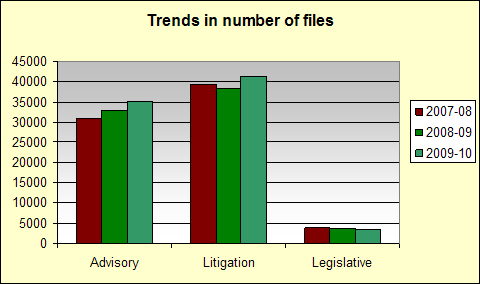
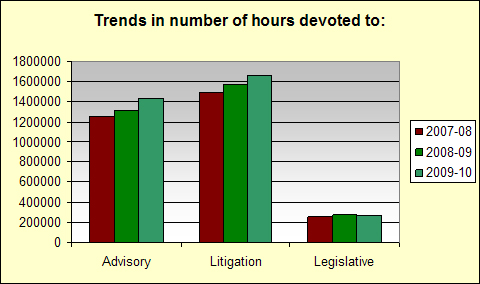
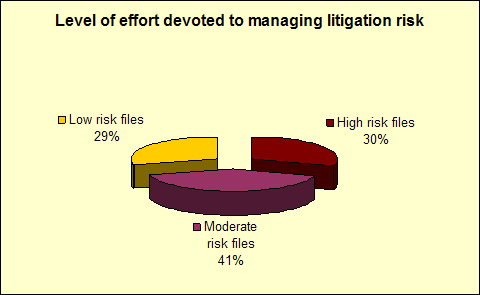
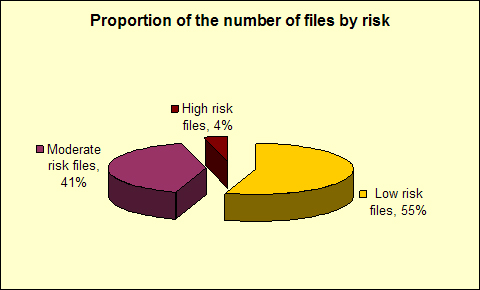
While only accounting for 4% of files, high risk litigation accounts for almost one third of the level of effort devoted to litigation files across the Department. In contrast, low risk files accounted for approximately the same proportion of the total level of effort devoted to litigation files, but they represent 55 % of the inventory. The Department closely monitors the risk profile in order to allocate resources to effectively address the government litigation inventory. The Department continued its efforts to work with client departments to identify and manage legal risks in an effort to mitigate those risks. High risk litigation files demand a significant proportion of departmental resources. The following are some examples of significant litigation during the reporting period:
United States of America v. Anekwu: The Supreme Court of Canada (SCC) resolved, in the Attorney General's favour, conflicting appellate decisions surrounding the admissibility of evidence collected in Canada in extradition proceedings. The decision is important in that it will contribute to a prompter and more efficient discharge of Canada's international obligations in extradition matters.
Prime Minister of Canada v. Omar Khadr: The SCC overturned a Federal Court of Appeal ruling ordering Canada to request Mr. Khadr's repatriation from his detention at Guantanamo Bay, Cuba. The decision was a reaffirmation of the importance of the Crown prerogative in the conduct of foreign relations.
Republic of Germany v. Schreiber: On August 2, 2009, Mr. Schreiber, who had been fighting his extradition from Canada to Germany for a decade, was surrendered to Germany for prosecution.
R v. McKay: The Federal Court of Appeal further clarified the scope of general anti-avoidance rules. The decision - from which leave to appeal to the Supreme Court of Canada was denied - precludes tax planners from alleging a nominal business purpose for a tax scheme to shield it from application of the scope of the general anti-avoidance rule.
Comprehensive delivery of the Government's legislative agenda
There was an increase in the number of bills drafted this year - up 10 from 48 to 58. Moreover, the number of Regulations published in Part I of the Canada Gazette increased by 32, while the number of Regulations published in Part II decreased by 50. There was a one percent increase over the reporting period in the number of hours devoted to the active management of legislative files including drafting of legislation and regulations.
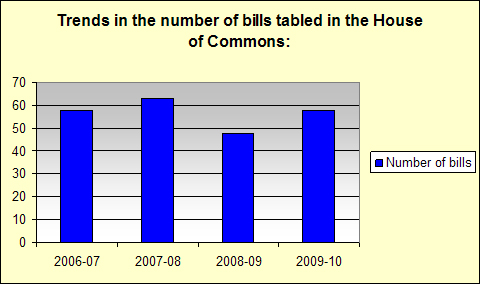
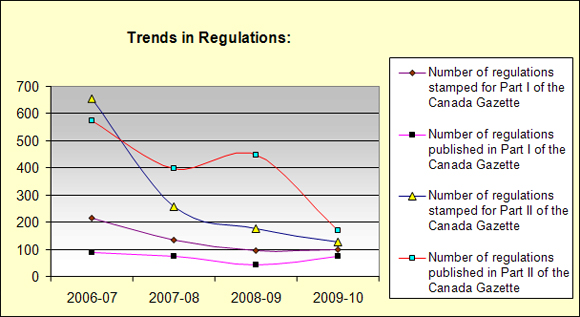
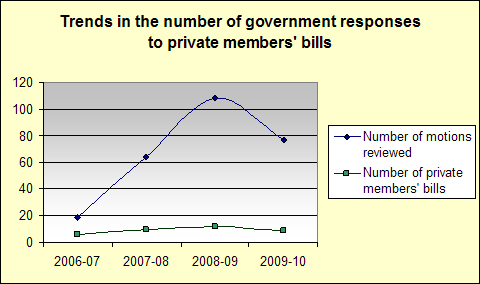
Client-focused service delivery
Beginning in April 2009, Standardized Legal Service Agreements between the Department of Justice and client departments have incorporated Departmental Service Standards. The Department conducts a cyclical client feedback survey on a three-year rolling basis across government.
In November 2009, over 14,000 potential respondents from 23 client departments and agencies4 were invited to participate in the Department of Justice Client Feedback Survey Cycle II. In total, 7524 respondents completed questionnaires, resulting in an overall response rate of 53%. Of these respondents, 3,032 individuals reported having used Justice legal services in the twelve months preceding the survey (40% usage rate).
Client feedback on the overall quality of legal advisory, litigation, legislative and regulatory drafting services is very positive. Average client ratings exceeded Departmental targets, demonstrating the Department's success in delivering client-focussed legal services.
The table on the next page highlights the client feedback on Departmental performance against service standards. For all service standards, the Departmental target is to attain a mean average rating of 8.0 on a ten-point Likert scale used to obtain feedback.
| Service Standard | Client Feedback by Type of Service5 | |||
|---|---|---|---|---|
| Advisory | Litigation | Legislative | Regulatory | |
| Overall Quality of Services | 8.3 | 8.2 | 8.4 | 8.4 |
| Provision of services in either official language | 9.3 | |||
| Provision of services with courtesy and respect | 9.0 | |||
| Provision of regular and informative progress reports or ongoing feedback | 7.0 | 7.6 | 7.2 | 7.4 |
| Provision of clear and practical guidance on resolving legal issues | 8.1 | 8.1 | N/A | N/A |
| Involvement of clients in the development of legal strategy and positions | 7.9 | 7.8 | N/A | N/A |
| Identification of means to prevent and resolve legal disputes at the earliest opportunity | 7.8 | 7.8 | N/A | N/A |
| Development of drafting options appropriate to client policy and program objectives | N/A | N/A | 8.2 | 8.2 |
| Proposing appropriate solutions for identified legal and drafting issues | N/A | N/A | 8.1 | 8.1 |
| Identification of opportunities to implement policies and programs by administrative rather than legislative or regulatory means | N/A | N/A | 7.7 | 7.4 |
| Timely response to requests for legal services | 7.5 | 8.0 | 7.9 | 7.8 |
| Negotiate mutually agreed upon deadlines | 7.6 | 7.8 | 7.8 | 7.6 |
| Meet mutually agreed upon deadlines | 7.7 | 8.0 | 7.8 | 7.7 |
Further details about the Department's performance at the sub-activity level can be accessed through its on-line results summary at: http://www.justice.gc.ca/eng/dept-min/pub/dpr-rr/2010/perfsumm-sommperf.html
Lessons Learned
The implementation of the Cabinet Directive on Streamlining Regulations may have reduced the number of Gazetted regulations in comparison to previous fiscal years. By introducing more rigorous analysis of policy proposals, the Directive has, for example, encouraged consideration of alternative instruments to regulations and greater reliance on standards. Continuous changes in client demand for legal services mean the Department of Justice needs to be nimble in being able to shift resources to meet client needs effectively and efficiently. The current operating environment is also one where the Department is continuously exploring ways to improve how it delivers its services.
The client feedback survey enables the Department to incorporate client perceptions into service delivery, identify areas where service improvements may be needed, and jointly monitor (with clients) progress in meeting client needs and expectations over time.
The most recent results from the Client Feedback Survey demonstrate the Department's commitment to delivering high quality legal services to support client departments. The survey results have identified that the Departmental performance is in line with the targets for most of the service standards, however, there are some areas where the feedback suggests room for improvement. In particular, the results suggest that there is a need to focus greater efforts on providing clients with regular and informative feedback or progress reports on the status of legal files.
Internal Services
| Program Activity C1: Internal services | |||||
|---|---|---|---|---|---|
| 2009-10 Financial Resources ($ millions) | 2009-10 Human Resources (FTEs) | ||||
| Planned Spending | Total Authorities6 | Actual Spending | Planned | Actual | Difference |
| $110.4 | $114.9 | $147.5 | 1,512 | 1,175 | 3377 |
Internal Services directly and indirectly support the provision of legal service to Government and the development of laws, policies and programs through the provision of information, advice, guidance and direction in a variety of areas, including: corporate legal services; human resources and professional development; information management and technology; administrative services (e.g., security, accommodations, contracting); planning and performance management; law practice management; gender-based analysis; communications; and financial management and control.
The Department's performance objective continues to be to meet or surpass government standards related to management capacity and practices as outlined and assessed through the annual Management Accountability Framework exercise led by Treasury Board Secretariat. The most recent assessment demonstrated that the Department is meeting or exceeding government standards in all areas of management assessed through the exercise. For further information regarding the MAF please see the Treasury Board Secretariat's web site at: http://www.tbs-sct.gc.ca/maf-crg/index-eng.asp.
- Includes Net Voting Authority of $229.1M some of which will be realigned to Program Activity "Internal Services" in fiscal year 2010-2011 to more appropriately align revenues to costs.
- Note: Variance between planned and actual FTEs is primarily attributable to an increased demand for legal services by other government departments and a realignment of FTEs to more accurately reflect the distribution by PAA as a result of recent requirements to report on Internal Services
- The Client Feedback Survey on the delivery of legal services uses a likert scale from 1 - 10 where 8.0 represents a very positive opinion of the quality of legal services. Cycle II which began in 2009-10 includes 23 depts. and agencies to date and has seen a 54% response rate.
- The following Departments participated in the survey: Atlantic Canada Opportunities Agency, Agriculture and Agri-Food Canada, Canadian Environmental Assessment Agency, Quebec Region Economic Development Agency, Canadian Food Inspection Agency, Canadian International Development Agency, Competition Bureau, Canadian Space Agency, Department of Fisheries and Oceans, Environment Canada, Foreign Affairs and International Trade, Health Canada, Canadian Heritage, Human Resources Development Canada, Industry Canada, Infrastructure Canada, Library and Archives Canada, National Research Council, Natural Resources Canada, Parks Canada, Public Works and Government Services Canada, Transport Canada.
- All reported client feedback ratings have a margin of error of ±0.2 or less at the 95% confidence level.
- The Authorities do not include the Internal Services costs related to the provision of legal services to other government departments. The total spending, however, includes that portion of the revenues collected by the Department under the Net Vote Authority associated with the total authorities for Program Activity B1 Services to Government. Net Vote Authority will be realigned from Program Activity "Services to Government" in fiscal year 2010-2011 to more appropriately align revenues to costs.
- Note: Variance between planned and actual FTEs is primarily attributable to an increased demand for legal services by other government departments and a realignment of FTEs to more accurately reflect the distribution by PAA as a result of recent requirements to report on Internal Services.
